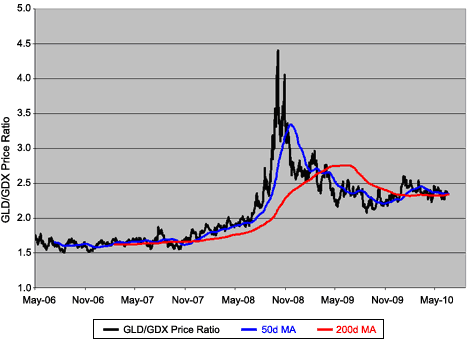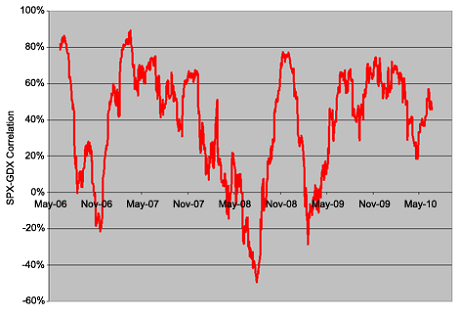The Gold-to-Gold-Stock Ratio
A key ratio for investors weighing a Gold Investment against Gold Mining stocks...
AFTER BREAKING DOWN in early June, the Gold Price has been pretty much fought to a standstill, writes Brad Zigler at Hard Assets Investor, leaving spot prices hovering around the $1200 level.
With the current resurgence in the equity markets, gold aficionados are left wondering whether Gold Mining shares may be a more profitable investment route than bullion when the market resumes trending.
If the past is the future's prologue, we may be able to read the market's entrails for guidance. Here at HardAssetsInvestor, we use a simple indicator to measure the relative strength of gold stocks to bullion: the GLD/GDX ratio.
GLD, of course, is the SPDR Gold Shares Trust (NYSE Arca: GLD), a grantor trust that holds physical metal, while GDX is the Market Vectors Gold Miners ETF (NYSE Arca: GDX), a portfolio tracking 32 producers comprising the NYSE Arca Gold Miners Index.
The ratio is simply the multiple by which the bullion proxy trades to the mining share benchmark. The ratio started life at 1.75, when the GDX exchange-traded fund was launched in May 2006, and reached an apex of 4.41 in the midst of the October 2008 financial market meltdown.

The ratio is a bellwether of equity market strength. More properly, it measures relative weakness, since the multiple rises as stock market woes mount.
Presently, the ratio's bumping against its 200-day moving average at 2.35. If gold stocks improve relative to bullion, we ought to see the ratio decline. If stock market troubles resume, however, we might see the ratio hold steady or rise.
Why the equivocation? Because the correlation of gold mining shares to the general stock market isn't particularly strong. Since inception, GDX's coefficient to the Standard & Poor's 500 Composite is only 39%.
That figure, of course, represents the GDX universe as a whole. If we peek under the hood at the ETF's top 10 components, we can apprehend each issue's particular sensitivity to the stock market. But looking back at gold mining shares' performance over the past four years,the miners' much-vaunted leverage failed to provide a return better than gold itself. Only two stocks produced compound annual growth rates better than gold's (as measured through the GLD bullion proxy): Channel Islands-based Randgold Resources Ltd. (Nasdaq: GOLD) and Vancouver's Eldorado Gold Corp. (NYSE: EGO).
Both issues have produced reward-to-risk ratios better than gold's, meaning their annual returns more closely match the volatility of their stock prices. (A reward-to-risk ratio of 1.00 would signify a gain of 1 percent for each additional percent point of standard deviation in the stock's price.) By and large, gold miners are very volatile stocks. The mean variation for GDX's top 10 issues is 60.1% compared with the S&P 500's 26.8%.
Note, as well, that the top-performing gold miners are also among those least correlated to the stock market. Randgold and El Dorado have truly been marching to the beat of a different drum. Is this trend likely to continue? It's hard to say. Certainly, some analysts are pulling in their horns with respect to Randgold; Goldman Sachs recently downgraded the stock when it reached the company's projected valuation. On the other hand, UBS AG analysts have raised their target for Eldorado's shares.
The real risk can best be seen in a macro view of Gold Mining stocks' correlation to the broader stock market. Correlation isn't static. At times, the correlation of mining shares to the general market can be quite high; at other times it's low. But note in the chart below how much time the 30-day rolling correlation of GDX to the S&P 500 spent above 60%, a relatively strong connection...

A high correlation to equities is a boon for mining shares when the stock market's trending upward. Otherwise, it's a performance drag. After all, mining stocks are stocks, right?
If you're a stock picker, you need to recognize the side bet you're making when selecting an individual issue for your portfolio. Can you reasonably quantify the likelihood of change in the stock's present correlation to the market?
If you can't, you're missing a big piece of the risk picture.
How best to buy gold today? "If there's a better way, I've yet to find it," says one Bullion Vault user...








 Email us
Email us